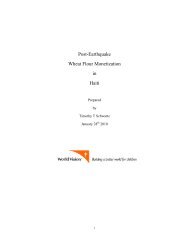BARR_Report_Ravine_Pentad_Final_v_31
You also want an ePaper? Increase the reach of your titles
YUMPU automatically turns print PDFs into web optimized ePapers that Google loves.
Introduction<br />
To assist and encourage people to return to their homes after the January 12 th 2010<br />
earthquake, USAID funded Rubble Removal Programs including demolition of condemned<br />
buildings and the removal of rubble from streets and drainage canals. Between February 2010<br />
and February of this year USAID also supported the Ministry of Public Works Transport and<br />
Communications (MTPTC) habitability assessments program in which buildings were<br />
structurally evaluated and color-coded green (for safe to return), yellow (one vertex<br />
compromised = could collapse in foul weather), and red (both vertices compromised = could<br />
collapse at any moment). The precise impact of rubble removal and the assessments on IDP<br />
returns was, prior to the current study, unknown.<br />
To determine the contribution the programs made, USAID contracted LTL Strategies to conduct<br />
the Building Assessments and Rubble Removal (<strong>BARR</strong>) surveys. The principal objective was to<br />
calculate, to a relatively high degree of accuracy and with a reasonably high degree of statistical<br />
probability, the impact on rate of re-occupancy of:<br />
a) MTPTC assessments on IDP returns,<br />
b) rubble removal<br />
Hypotheses,<br />
1. The program of habitability assessment encourages the return home of IDPs<br />
2. The rubble removal program encourages the return home of IDPs<br />
The surveys also presented an opportunity to resolve issues important to the reconstruction and<br />
housing effort as discussed and highlighted by participants in the October 4th IHRC Meeting on<br />
Housing Reconstruction and Transitional Shelter. Specifically, obstacles to home return; reoccupancy<br />
rates of yellow and red building; occupant knowledge of damages and capacity to<br />
repair homes; tenure issues (titles, proportion of renters); relationships between return rates<br />
and neighborhood services, opinions of camps.<br />
<strong>BARR</strong> survey’s principal focus was a 55 cluster, 3,784 residential building survey of Port-au-<br />
Prince neighborhoods severely impacted by the earthquake; and application of the <strong>BARR</strong><br />
residential building questionnaire to one owner or renter in approximately half of those buildings<br />
(1,928). <strong>BARR</strong> also included focus groups and key informant interviews. But before the Port-au-<br />
Prince cluster samples were conducted, the <strong>BARR</strong> team carried out a pilot study the Port-au-<br />
Prince neighborhood <strong>Ravine</strong> <strong>Pentad</strong>. This companion report focuses on the <strong>Ravine</strong> <strong>Pentad</strong> Pilot<br />
Study.<br />
<strong>Ravine</strong> <strong>Pentad</strong><br />
<strong>Ravine</strong> <strong>Pentad</strong> is a densely settled, 16.5 acre Port-au-Prince community (~110 x 600 meters).<br />
Until the 1960s and 1970s the area comprised the surviving estates of Port-au-Prince gentry,<br />
the Church, and the State in the form of the National Bank. Today it is a covers the spectrum<br />
from impoverished shanties to three story homes of the original landowners. An improved<br />
drainage canal cuts through the bottom of the ravine bisecting the neighborhood into east and<br />
west sectors. Slopes on either side range from 30 – 60 degrees (Kessler 2010). Considered<br />
among the most severely earthquake damaged neighborhoods in Port-au-Prince, in the months<br />
following the earthquake PCI (Project Compassion International) and USAID funded CHF<br />
(Cooperative Housing Foundation) assisted the community in recovering and rebuilding.<br />
1
















